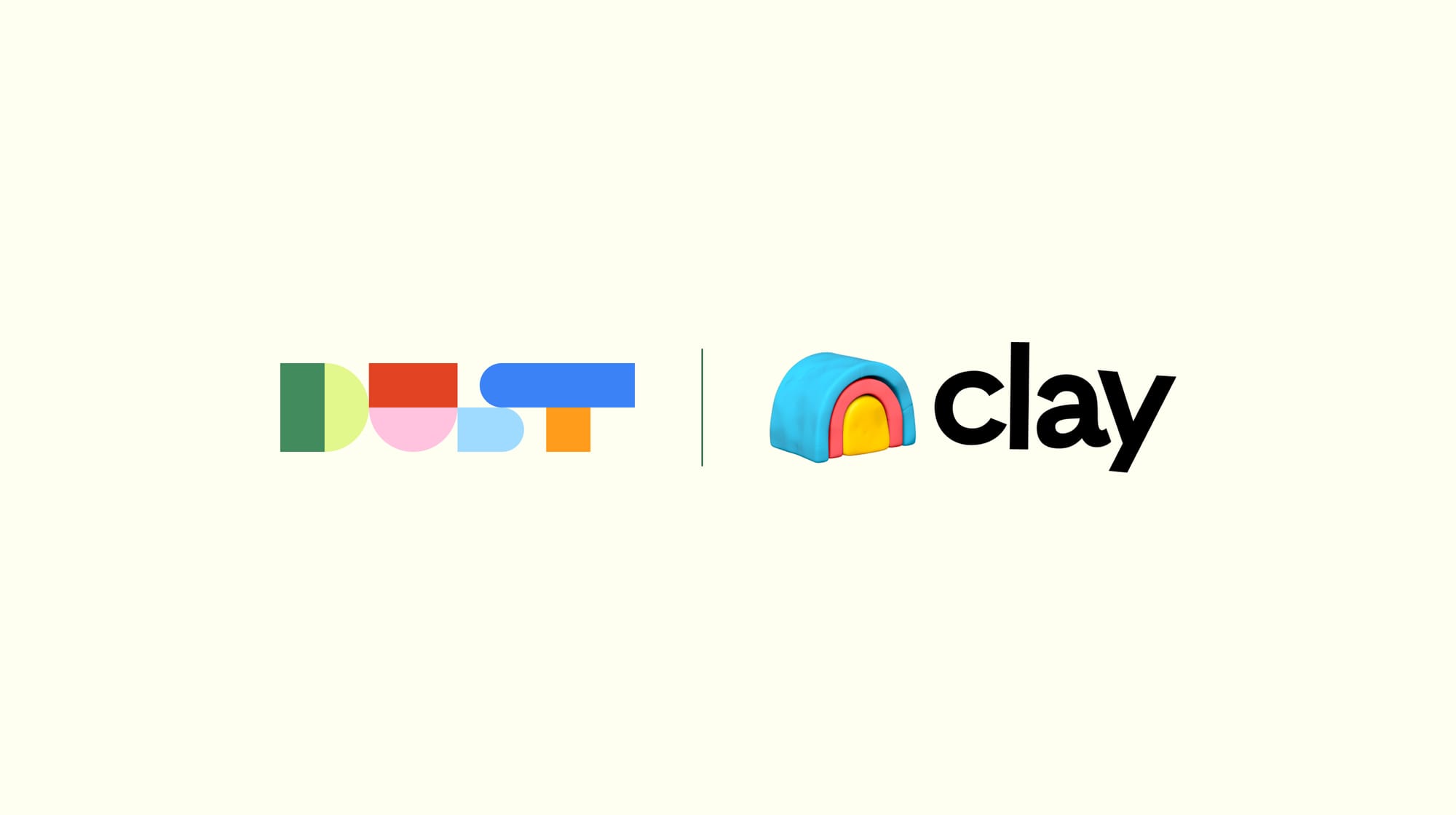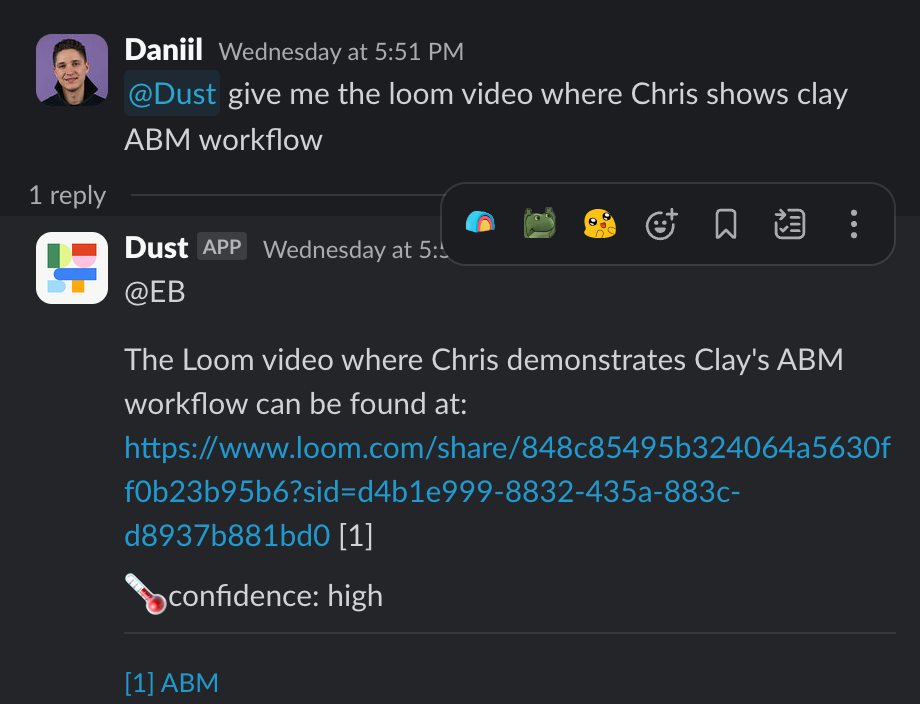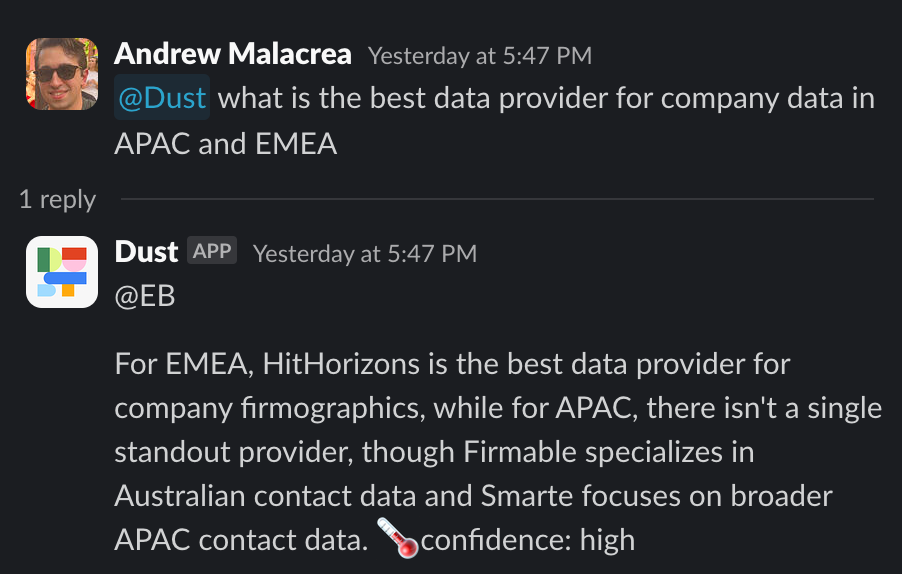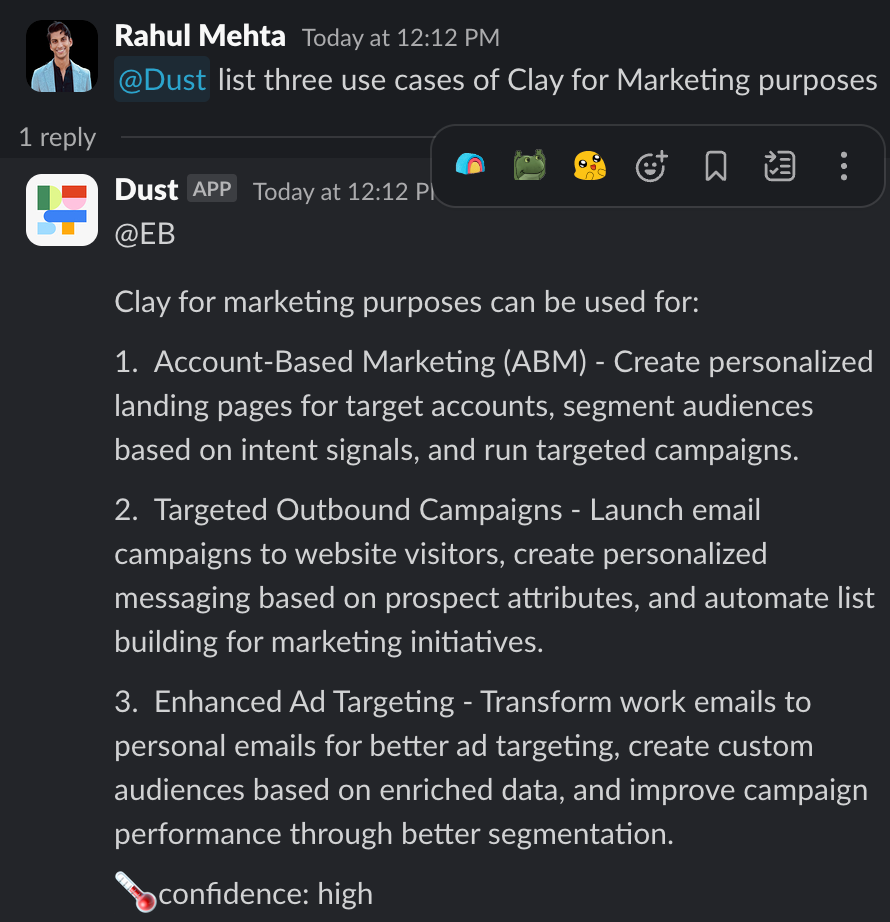How Clay is powering 4x team growth with Dust

Over the past two years, Clay went from a startup with virtually no revenue to a powerhouse valued at $1.5bn with over 8,000 customers and 130+ integrations with world-class data partners. During this period of exponential growth, one of Clay’s biggest priorities has been scaling their mission-critical GTM engineer team — without adding significant cost or burden to the process. We sat down with Caren Duane from the Operations team at Clay, to understand how Dust is helping the company through this period of hyper-growth.
About Clay
Clay is a tool for go-to-market (GTM) teams to grow revenue by providing access to over 130+ external data providers in a single place. Its key features include waterfall enrichments that can search multiple providers sequentially, automated workflows that eliminate repetitive tasks, and AI agents that handle everything from research to crafting personalized messages. This combination helps their customers—from startups to enterprises—achieve GTM efficiency at scale.
Challenge: 4xing the GTM team at scale
Clay is broadly known for pioneering the idea of a GTM Engineering (GTME) team. GTM Engineers architect systems that drive revenue through automation and scalable processes. That could include automating CRM entries and pre-call meeting notes for reps, running hundreds of personalized outbound campaigns, or tracking themes in support tickets and automating proactive churn-mitigation campaigns. Uniquely, Clay hires GTM Engineers as its own sellers, too. Since they're selling to their peers, they have a deep understanding of customer pain points. "It’s a unique, multifaceted role where you need to be an expert about the product, the sales process, and the GTM space,” Caren explains.
Since joining Clay's GTM Operations team in September 2024, her mission has been to figure out how to efficiently support the meteoric growth of the GTM engineer team—specifically with the help of AI. Her focus narrowed to two critical priorities:
1. Increasing onboarding speed
With plans to 4x the team of GTM engineers in 2025, Caren knew they needed to prepare for an influx in headcount—fast. Specifically, she wanted to make sure every new hire always had someone to unblock them on questions, with the goal of faster onboarding and fewer bottlenecks.
But the pace of knowledge acquisition at Clay is remarkable. With 10+ integrations launching every month and countless feature updates, GTMEs must stay current with the rapidly evolving product to deliver the best customer experience. And Caren recognized that the traditional “onboarding buddy” approach wouldn't suit this fast-moving, agile team.
2. Making sales enablement more accessible for busy GTMEs
Caren was also focused on setting up infrastructure that would empower the GTME team to be efficient at their jobs. She put together a comprehensive knowledge hub with 100+ resources—which included everything from playbooks to sales decks. But she knew that discoverability was going to be an issue, given the constantly evolving nature of the content and the limited bandwidth of the GTME team.
Solution: Using Dust to enable a scalable self-service knowledge hub
Caren knew she had to find a way to let people self-serve when they have questions—it was just a matter of how. The answer appeared serendipitously during a team meeting when someone mentioned Dust. Caren's interest was immediately piqued. "I was trying to move really quickly because we had a bunch of new hires starting, and everything I was looking for, it seemed like Dust had."
Implementation: From decision to live agent in 24 hours
Once she confirmed that Dust was the solution they needed, Caren didn't hesitate. And thanks to the culture at Clay, she was able to move fast on her decision. "One of the reasons why working at Clay is amazing is because if you're excited about something and can prove it out, you have the freedom to pursue it."
After initiating her use of Dust in December 2024, Caren had a working agent set up in just 24 hours. Before rolling it out to the rest of the team, she took time to assess where the implementation could deliver the most value. "Looking holistically at Clay, I asked myself: where would this tool be useful? Where does it make sense for Dust to plug in? After going through that process, it was clear that enablement for the GTME team was the first place to start."
Integration: Connecting Dust to Clay's information ecosystem
Rather than building a knowledge base from scratch, Caren connected Dust to Clay's existing ecosystem of documentation. She prioritized their sales center—where all their most important resources were linked—as the foundation, making that where the Dust agent looks first.
"I've directed Dust to always check our sales center first for things like DPAs or links to our sales deck," Caren says. "Stale links are a big issue on sales teams, especially as they get bigger, so having a single source of truth is crucial."
Adoption: Embedding Dust into daily workflows
For any tool to succeed, it needs to fit naturally into existing workflows. Caren embedded Dust directly into Slack, where Clay employees spend most of their time. Specifically, she created a separate channel where the GTME team could ask the Dust agent their questions.
Given that Clay’s Slack environment spans over 100 channels, having a single place for the GTME team to find answers proved to be invaluable. "Questions used to flood our main team channels with interruptions like 'Where do I find the MSA?' Now they live in a separate channel, so nobody gets distracted by basic information requests." This has also significantly reduced noise across Clay’s communication ecosystem by eliminating repetitive questions.

Embedding Dust into Slack proved especially valuable for new hires, who frequently need access to sales documentation and answers to common questions. For example, if a new team member wants to understand how to talk about a certain Clay competitor, they could ask Dust, which would pull from a variety of sources—from the knowledge hub to recent Slack conversations—to instantly provide the most up-to-date information.

Customization: Building a full-spectrum resource for the GTME team
For standard, established information, Dust relies on official documentation. But Clay's rapid pace of innovation created an interesting challenge, which is that the sales center couldn't possibly cover everything in real-time.
Caren used Dust to solve this problem: "The sales center doesn't cover everything because the product is evolving so quickly. So Dust will also pull from Slack conversations and other docs that might not yet have an official stamp of approval." This hybrid approach stitched together all of the GTME team’s fragmented sources of information into a single location.
"It’s not just about retrieving information from one place. Our sales team needs information that’s often scattered across multiple internal applications. Dust brings it all together." Caren, Operations Team
And as people ask questions and receive responses from the Dust agent, these conversations become the most up-to-date sources of information—creating a live knowledge base that evolves alongside Clay’s rapid development.

Caren also enabled the Dust agent to answer questions raised by the GTME team privately. The result is a system that supports the full spectrum of the sales function. "This singular channel is where people ask every sales enablement question—from procurement and pricing to product capabilities to process guidance. It's become our central knowledge hub," Caren says.
Results: A broadly accessible, scalable knowledge base for the GTME team
Democratized information access
With any investment in a new tool, every champion's biggest hurdle tends to be adoption rates. If nobody uses the product, there's no way to tell if it's working. Thankfully, for Clay, this hasn't been a problem with Dust, which has achieved a 100% adoption rate within the GTME team—with especially high usage among newer employees.
Caren says Dust has made it possible for any team member to get the information they need when they need it. This democratization of information, according to Caren, has been one of the most powerful outcomes.
"Dust democratizes information access, so it's no longer about who joined the company the earliest or who sits closest to the Head of Sales or who has the better onboarding buddy. Now there's just a single source of truth for everyone to point to." Caren, Operations Team

Significant time savings and reduced attention fragmentation
A huge signal of success for the Clay team comes from the quantifiable time savings. "With 10 new people joining each month, each asking an average of 10 questions daily, the time savings quickly compound," Caren explains.
By incorporating Dust into their onboarding and enablement process, the GTME sales team of 20 currently saves around 58 hours each month—more than a full work week reclaimed for higher-value activities.
Beyond the numbers, there's the qualitative improvement in the onboarding experience. New hires no longer have to "drink from the fire hose" or sit around waiting to be unblocked on critical questions. Instead, they can access information at their own pace, creating a more sustainable learning curve and a better overall experience. Similarly, with Dust providing a single channel where all questions are answered by an agent, team members can protect their attention and stay focused on higher-priority tasks.

Caren has also saved a significant amount of time by using Dust as a job description writer, a legal document reviewer, and even a content creation accelerator. "A month ago, someone asked, 'Who are all our competitors? And how do we talk about them?' I plugged that into Dust and had a list of 100 companies within 30 seconds—something that would normally take days to compile."
Tighter feedback loops
One unexpected benefit Caren discovered was that she could use Dust as a powerful feedback mechanism. "I'll query Dust with something like, 'hey, give me a summary from the last month of the most common things people have questions on.' The output then helps us prioritize what we need to focus on next." This feedback loop has led to concrete improvements.
"Last month, we noticed there were a lot of questions around pricing, so we're now doing more intensive pricing enablement and documentation. The questions people ask Dust directly inform our strategy." Caren, Operations Team
The future of Dust <> Clay
After seeing the success with their GTME, other teams—such as product support and growth strategy—have adopted Dust for their own use cases.
"Each team has different knowledge priorities," Caren explains. "What the sales team needs to access first is completely different from what the support team considers essential. Our team-specific approach ensures everyone gets information tailored to their context." While Caren began as the sole builder of these agents, team members who initially focused simply on using the tool are now expressing interest in creating their own specialized agents as well.
With the GTME team on track to quadruple this year, Clay has found a strategic advantage with Dust—one that allows them to maintain their growth velocity while ensuring every team member has access to the information they need to succeed. The relationship has come full circle as Dust has also become a customer, using Clay’s data enrichment platform to power growth initiatives. “For fast-growing startups, Dust is the way to scale knowledge,” Caren says.

